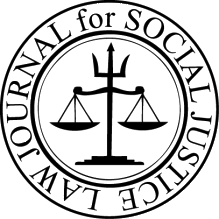VOLUME VI, Spring 2016 | Law Journal for Social Justice
Editor’s Note:
The 2016 Law Journal for Social Justice Symposium, “Promising Practices in Criminal Justice” focused on current programs regarding re-entry and rehabilitation. Discussions ranged from specialty court programs like the Veteran’s Court and Homeless Court, victim-oriented rehabilitation for trafficking victims, and re-entry programs. Panelists included judges, practicing attorneys, and community organizers.
Social justice is an evolving, broadening concept, finding new meaning throughout the academic community. This journal, and the articles found herein, is designed to present these emerging concepts in a manner that allows both the jurist and the layperson to engage them. The issue begins with Zoning and Regulating for Obesity Prevention and Healthier Diets: What Does the South Los Angeles Fast Food Ban Mean for Future Regulation?, written by Kim Weidenaar, an article commenting on local zoning ordinances as tools for preventing obesity in disproportionately affected populations. However, with the second article, Eating Mascots for Breakfast: How Keeping Native Faces off Labels Can Grow Tribal Economies, Leah K. Jurss concentrates on food sovereignty in tribal communities and labeling of Native food products. Alex D. Ivan then shifts the focus by studying how electronic monitoring may be used to empower victims while reducing burdens of imprisonment spending in Utilizing Electronic Monitoring to Enhance Domestic Violence Victim Safety. Next, in Constitutional Protection of Domestic Violence Victims Reinforced by International Law Marina Kovacevic argues ratification of the Convention on the Elimination of all forms of Discrimination Against Women (CEDAW) in the United States. Sara Movahed, in Devastating Effects of the International Failure to Recognize Refugees of Gender Based Persecution, then examines legal shortcomings resulting when asylum based solely on a history of gender-based persecution is not considered. Through Kennedy’s Law: The Hidden Constitutionally-Protected Classification, Nicole Fries explores the necessity of Supreme Court action to provide lower courts the ability “to apply a suspect class framework to non-marriage sexual orientation laws.” Next, Erin Iungerich, in My Nurse is a Pornstar: Should Discrimination Law Protect Moonlighting in the Adult Industry?, considers protections for at-will employees participating in adult industry activities after-hours. Finally, Secrecy, Espionage, and Reasonable Efforts Under the Uniform Trade Secrets Act – An Unbalanced Mass by Peter L. Krehbiel concludes the issue by analyzing concerns that shifting costs related to trade secrets may undermine public policy and society at large. Collectively, the unique perspectives of these articles present important domestic and international issues that must be examined in today’s changing landscape.
Special thanks to the Law Journal for Social Justice Editorial Board for their hard work and dedication.
Asha McManimon
2015-2016 Editor-in-Chief, Law Journal for Social Justice
Spring 2016 issue by article:
Zoning and Regulating for Obesity Prevention and Healthier Diets: What Does the South Los Angeles Fast Food Ban Mean for Future Regulation? by Kim Weidenaar
Eating Mascots for Breakfast: How Keeping Native Faces off Labels Can Grow Tribal Economies by Leah K. Jurss
Utilizing Electronic Monitoring to Enhance Domestic Violence Victim Safety by Alex D. Ivan
Constitutional Protection of Domestic Violence Victims Reinforced by International Law by Marina Kovacevic
Devastating Effects of the International Failure to Recognize Refugees of Gender Based Persecution by Sara Movahed
Kennedy’s Law: The Hidden Constitutionally-Protected Classification by Nicole Fries
My Nurse is a Pornstar: Should Discrimination Law Protect Moonlighting in the Adult Industry? by Erin Iungerich
Secrecy, Espionage, and Reasonable Efforts Under the Uniform Trade Secrets Act – An Unbalanced Mass by Peter L. Krehbiel
